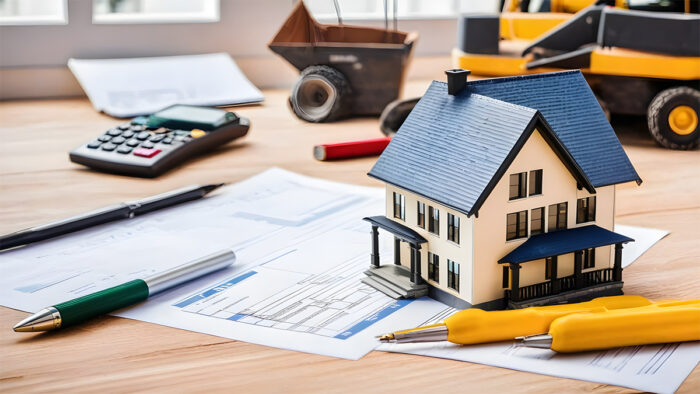Creating a residence from the ground up creates expenses; however, a construction loan provides initial funds for land, materials, and labor to build a new house, facilitating the process.

While construction loans empower borrowers to bring their dream home to life, it’s important to note that there are inherent risks. Moreover, it comes with elevated interest rates and more substantial initial down payments compared to conventional mortgages.
What is a Construction Loan?
A construction loan, often referred to as a “self-build loan,” is a brief financial arrangement utilized to fund the construction of a residence or another real estate venture. Construction loans cover various building expenses, including land acquisition, architectural plans, permits, and labor and material costs, facilitating comprehensive funding for construction projects.
Furthermore, these loans can also access contingency reserves, offering financial backup if the project exceeds the initially budgeted amount. Additionally, construction loans may incorporate interest reserves, allowing individuals to avoid interest payments during the construction phase if preferred.
Due to their perceived riskiness, construction loans typically carry higher interest rates compared to standard mortgage loans.
How Does Construction Loan Work?
Construction loans empower prospective homeowners to borrow funds, covering the expenses of materials and labor essential for building a residence. However, this financial support can extend to the acquisition of the land where construction is planned.
If the land is already owned, it might serve as collateral for the loan. Furthermore, it usually lasts 12–18 months, which aligns with building timelines. Some seamlessly convert to permanent mortgages after construction completion.
Lenders often require a thorough examination of architectural plans and financial circumstances before granting approval. Moreover, providing an estimated construction timeline and budget is usually necessary.
Upon approval, the borrower doesn’t receive the entire loan amount upfront. Instead, the lender disburses funds to the builder in stages or draws as construction progresses.
This setup operates akin to a line of credit. Draws are aligned with the construction timeline, and lenders often dispatch inspectors to assess the construction status before each payment.
During the construction phase, borrowers typically repay interest only on the drawn funds, not the entire loan amount. Depending on the lender, there may be an option to convert the construction loan into a mortgage post-construction.
Alternatively, borrowers can seek a mortgage, also known as an end loan, to settle the construction loan.
Types of Construction Loans
The process of building a home is diverse, accommodating the unique needs of future homeowners through a range of construction loans. Two primary types are construction-to-permanent and construction-only loans, each tailored to specific requirements.
• Construction-to-Permanent Loan
This type of loan funds the construction of a home and seamlessly transitions into a fixed-rate mortgage once the construction is finished. Moreover, it is an ideal choice for homeowners looking to minimize closing costs and secure long-term mortgage financing.
• Construction-Only Loan
To support the finalization of home construction, the lender provides a short-term, adjustable-rate loan. In addition, the borrower faces the choice of repaying the loan in full or refinancing it into a mortgage.
This involves two separate application processes and closings. This approach is well-suited for individuals with ample available cash or those intending to use proceeds from the sale of their previous home to settle the construction loan.
• Owner-Builder Construction Loan
Home construction loans for owner-builders come in two main types: construction-to-permanent and construction-only loans. What sets these apart is that the borrower, in this case, assumes the role of the home builder.
Lenders often approach construction loans cautiously, expressing concerns about the complexities of home construction and the expertise required for building codes. However, lenders are more open to this arrangement if the borrower holds a professional builder’s license.
• Renovation Loans
Similar to a conventional mortgage, renovation loans cater to both home purchases and significant renovations. The loan amount is determined by the expected post-renovation value of the home.
Individuals acquiring a fixer-upper with plans for substantial renovations often opt for these loans.
What Does a Construction Loan Cover?
Construction loans typically cover all new home building expenses, including land, permits, labor, and materials, streamlining funding for the project. Additionally, comparable to other home loans, construction loans also factor in closing costs.
Construction Loan rates
In contrast to fixed-rate traditional mortgages, construction loans typically feature variable rates tied to the prime rate. Consequently, your monthly payment may vary, either increasing or decreasing in response to fluctuations in the interest rate.
In addition, construction loan rates generally tend to be higher than those of traditional mortgages. This is partly attributed to the unsecured nature of construction loans, as they lack the collateral provided by a home.
In a traditional mortgage, your home serves as collateral, allowing the lender to seize it in the event of a payment default. Construction loans, lacking this collateral, are perceived as higher risks by lenders, contributing to the comparatively elevated interest rates.
Typically, the average interest rates for construction loans are approximately 1 percentage point higher than the rates associated with traditional mortgages.
Requirements for Getting a Construction Loan
Lender-specific requirements for construction loans may vary, but several common borrowing guidelines include:
• Good Credit Score
To mitigate risk, lenders often mandate a minimum credit score of 680 for construction loan eligibility. Nevertheless, certain lenders might stipulate a higher credit score, prompting the need to explore various options and assess guidelines.
If building a home is on your agenda, enhancing your credit score prior to applying for a construction loan is advisable. Securing a construction loan necessitates a low debt-to-income ratio and the provision of evidence demonstrating ample income to meet the repayment obligations of the loan.
• Down Payment to 20%
A down payment is a requisite when applying for a construction loan, mirroring the common practice in most mortgage agreements. Typically, lenders do not finance the entire project, and the specific percentage required depends on both the lender and the amount sought for construction expenses.
However, construction loans typically necessitate a minimum down payment of at least 20 percent. Certain lenders might impose a higher down payment requirement, ranging from 25% to 30% of the total loan amount.
• Low Debt-to-Income (DTI) Ratio
The debt-to-income (DTI) ratio gauges the relationship between all your monthly debt payments, including the new construction loan, and your gross monthly income.
Furthermore, it’s essential to have sufficient income to cover existing debts as well as the new construction loan. Lenders commonly stipulate a maximum DTI ratio of 45% for construction loans, ensuring borrowers have the financial capacity to meet their obligations.
• Home Appraisal
Whether it’s a construction-only or construction-to-permanent loan, lenders prioritize ensuring the home’s value justifies the loan amount. However, an appraiser will review various factors, including blueprints, lot value, and other pertinent details, to determine an accurate valuation.
Additionally, in the case of construction-to-permanent loans, once construction concludes, the completed home becomes collateral for the mortgage. Engage in discussions with various prospective lenders and ensure a thorough understanding of the terms before committing to any agreements.
How to Apply for Construction Loan
Securing approval for a construction loan may appear akin to the steps involved in securing a mortgage, yet obtaining the green light to commence construction on a new residence entails a slightly more intricate process.
To navigate this, adhere to the following four steps:
• Licensed Builder
Selecting a licensed and reputable home builder is a crucial step before pursuing a construction loan. Opt for a builder with a demonstrated history of successfully completing construction projects to high standards.
Choosing a builder affiliated with respected groups like the National Association of Home Builders enhances credibility and commitment to industry standards.
• Get a Loan Lender
Explore offerings from multiple seasoned construction loan lenders to gather information regarding their distinctive programs and processes. In the event you encounter challenges in finding a willing lender, consider exploring options with smaller regional banks or credit unions.
Thoroughly assess and compare construction loan rates, terms, and down payment requirements to secure the most favorable deal tailored to your specific situation.
• Gather Documents
Expect the lender to request a comprehensive contract with your builder, outlining detailed pricing and project plans. Ensure that you have credible references for your builder and the necessary evidence of their business credentials.
Additionally, be prepared to furnish similar financial documents required for a traditional mortgage, such as pay stubs and tax statements, providing substantiation of income, assets, and employment. This documentation is crucial in the loan approval process.
Get Preapproved
Attaining preapproval for a construction loan offers valuable insights into the borrowing capacity for your project. Furthermore, this step is crucial as it prevents unnecessary expenses on architect plans or home blueprints that might exceed your financial reach.
By getting preapproved, you gain a clear understanding of the feasible loan amount, aiding in informed decision-making before investing in detailed project plans.
Get Homeowner’s Insurance
Despite not residing in the home during construction, your lender will probably mandate a prepaid homeowner’s insurance policy with builder’s risk coverage. This precautionary measure ensures protection in case of unforeseen events during the construction phase, such as a fire or vandalism.
By securing this insurance upfront, you safeguard both your investment and the lender’s interests during the construction process.
Conclusion
Construction loans can be a practical means to achieve ownership of your dream home. However, carefully managing the loan principal is crucial. Taking time to evaluate options and gain a comprehensive financial understanding is essential for informed decision-making.



